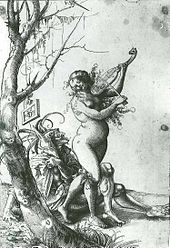Urs Graf

Urs Graf(c. 1485 inSolothurn,Switzerland– possibly before 13 October 1528)[1]was aSwissRenaissancegoldsmith,painterandprintmaker(ofwoodcuts,etchingsandengravings), as well as aSwiss mercenary.He only produced two etchings, one of which dates from 1513 – the earliest known etching for which a date has been established. However, his woodcuts are considered of greater significance, particularly as he is attributed with the invention of the white-line woodcut technique, where white lines create the image on a black background. He also produced a few engravings, including copies of works byMartin SchongauerandAlbrecht Dürer.[2]He produced innovative drawings intended as finished works of art rather than just studies.
Biography
[edit]Graf learnedgoldsmithingfirst from his father, Hugo Graf, then from a goldsmith inZürich.He continued to work as a goldsmith and a few pieces survive. He initially earned money as a designer of woodcut book illustrations and by assisting thestained glasspainter, Lienhart Triblin. In 1511 he designed the book cover for theDecretum Gratianifor the printersJohann Amerbach,Johannes PetriandJohannes Froben[3]and by 1512 Graf designed the cover of book with thesermonsof the deceasedJohann Geiler von KeysersbergforAdam Petri,[4]the successor and nephew from Johannes Petri. In 1512, he bought citizenship inBaseland became a member of the goldsmiths'guild.He quickly came into conflict with the law for abusing his wife and consorting withprostitutes,culminating in accusations ofattempted murderwhich caused him to flee the city in 1518. He was allowed to return to Basel the following year, where he continued working, but after 1527 his life becomes unclear. Given his frequent employment as a soldier of fortune it is possible he was present at thesack of Rome.[5]Christiane Andersson noted that, "When and where he died are unknown: his wife remarried in October 1528 but an autograph drawing is dated 1529".[6]
Like many Swiss men of his day, Graf was known to have worked as amercenaryfor considerable periods. His artistic output, arising from the tradition of Albrecht Dürer andHans Baldung,includes a wide range of subjects, depicting social, erotic, military, political, and criminal images (e.g.,Two Prostitutes Beating a Monk), as well as strong religious feelings which emerge in some works.[6]
References
[edit]- ^Martin Rohde:Graf, Urs (der Ältere)inGerman,FrenchandItalianin the onlineHistorical Dictionary of Switzerland,2005-12-01.
- ^Arthur M. Hind.A History of Engraving and Etching.Houghton Mifflin Co., 1923 (in US), reprinted Dover Publications, 1963.ISBN0-486-20954-7
- ^Hieronymus, Frank (1997).1488 Petri-Schwabe 1988: eine traditionsreiche Basler Offizin im Spiegel ihrer frühen Drucke(in German). Schwabe. pp. 53–54.ISBN978-3-7965-1000-7.
- ^Hieronymus, Frank (1997).p.98
- ^P. Murray & L. Murray, 'The Penguin Dictionary of Art & Artists' (p.198 section G) Harmondsworth, 1959 (1982 revision)
- ^abAndersson
- Christiane Andersson. "Graf, Urs."Grove Art Online.Oxford Art Online. Oxford University Press. Web. 26 Feb. 2013.[1]
External links
[edit]- Bible. N.T. Gospels.Latin. 1506.[Strassburg, J. Knobloch, 1506?] Engravings: Urs Graf. From theLessing J. Rosenwald Collectionat theLibrary of Congress
 Media related toUrs Grafat Wikimedia Commons
Media related toUrs Grafat Wikimedia Commons
